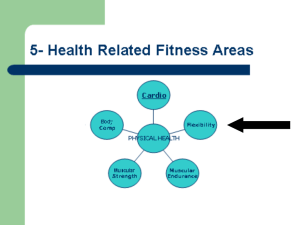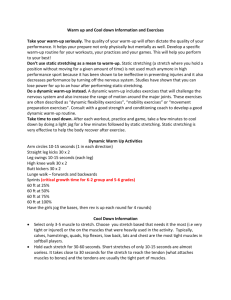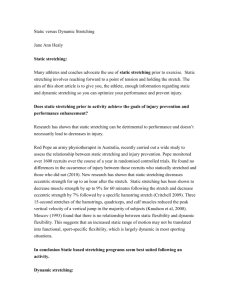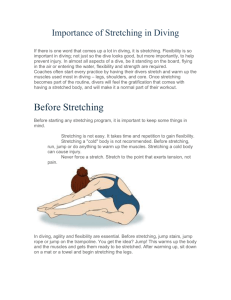`Recovery Week 2` - Mobility
advertisement
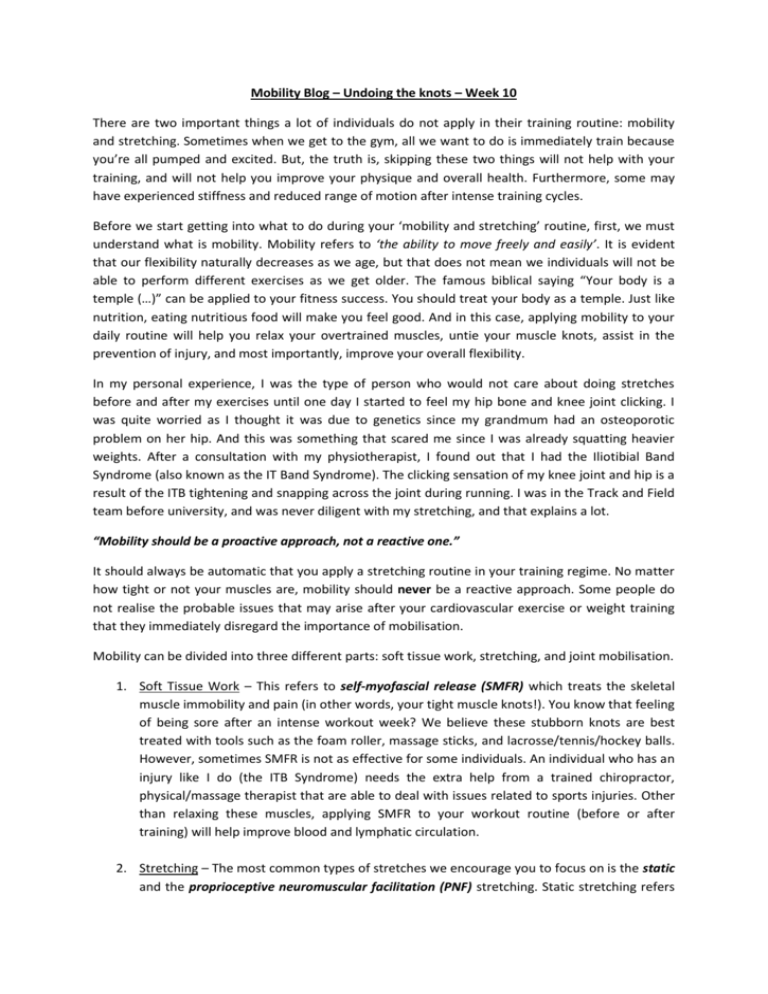
Mobility Blog – Undoing the knots – Week 10 There are two important things a lot of individuals do not apply in their training routine: mobility and stretching. Sometimes when we get to the gym, all we want to do is immediately train because you’re all pumped and excited. But, the truth is, skipping these two things will not help with your training, and will not help you improve your physique and overall health. Furthermore, some may have experienced stiffness and reduced range of motion after intense training cycles. Before we start getting into what to do during your ‘mobility and stretching’ routine, first, we must understand what is mobility. Mobility refers to ‘the ability to move freely and easily’. It is evident that our flexibility naturally decreases as we age, but that does not mean we individuals will not be able to perform different exercises as we get older. The famous biblical saying “Your body is a temple (…)” can be applied to your fitness success. You should treat your body as a temple. Just like nutrition, eating nutritious food will make you feel good. And in this case, applying mobility to your daily routine will help you relax your overtrained muscles, untie your muscle knots, assist in the prevention of injury, and most importantly, improve your overall flexibility. In my personal experience, I was the type of person who would not care about doing stretches before and after my exercises until one day I started to feel my hip bone and knee joint clicking. I was quite worried as I thought it was due to genetics since my grandmum had an osteoporotic problem on her hip. And this was something that scared me since I was already squatting heavier weights. After a consultation with my physiotherapist, I found out that I had the Iliotibial Band Syndrome (also known as the IT Band Syndrome). The clicking sensation of my knee joint and hip is a result of the ITB tightening and snapping across the joint during running. I was in the Track and Field team before university, and was never diligent with my stretching, and that explains a lot. “Mobility should be a proactive approach, not a reactive one.” It should always be automatic that you apply a stretching routine in your training regime. No matter how tight or not your muscles are, mobility should never be a reactive approach. Some people do not realise the probable issues that may arise after your cardiovascular exercise or weight training that they immediately disregard the importance of mobilisation. Mobility can be divided into three different parts: soft tissue work, stretching, and joint mobilisation. 1. Soft Tissue Work – This refers to self-myofascial release (SMFR) which treats the skeletal muscle immobility and pain (in other words, your tight muscle knots!). You know that feeling of being sore after an intense workout week? We believe these stubborn knots are best treated with tools such as the foam roller, massage sticks, and lacrosse/tennis/hockey balls. However, sometimes SMFR is not as effective for some individuals. An individual who has an injury like I do (the ITB Syndrome) needs the extra help from a trained chiropractor, physical/massage therapist that are able to deal with issues related to sports injuries. Other than relaxing these muscles, applying SMFR to your workout routine (before or after training) will help improve blood and lymphatic circulation. 2. Stretching – The most common types of stretches we encourage you to focus on is the static and the proprioceptive neuromuscular facilitation (PNF) stretching. Static stretching refers to the basic movements that stretch out specific target muscle to the point of mild discomfort, in a lengthened position (ranging from 10 seconds to 60 seconds). It is the most common type of stretch as it remains effective and relatively safe. PNF stretching focuses on isometrically contracting and relaxing the specific tight muscles. We recommend checking out Kelly Starrett for his tips on PNF stretching. 3. Joint Mobilisation – This focuses on mobilising your specific joints. Joint issues can negatively impact your compound exercises especially your squats. Having my ITB syndrome, joint mobilisation is crucial for me. The main goal is to increase extensibility of a joint capsule by breaking up adhesions and/or stretching the capsule itself. Kelly Starrett explains the technique of mobilising your joints that involves using stretch bands that distracts the specific joint. However, you should also be cautious if you feel like intense discomfort or especially, are very prone to dislocations. Below are the different mobility exercises for the most common tight and overused muscles: T-Spine Smash Extension predominantly massages the bottom of your ribcage to the base of the neck and the top of the scapula (mainly hitting the rhomboids and the trapezius). It will improve your normal posture, stable shoulder position, global extension, and thoracic extension. To begin, wrap your arms around your chest and position the roller at the base of your ribcage. Roll and make sure you pull the soft tissue and the scapula out of the way so that you can target the motion segments of your back. To create an extensive force, arch your back, making sure to target all the necessary areas, by sliding downwards and upwards. Olympic Wall Squat with External Rotation improves flexion and external rotation. When doing this stretch, you must remember to contract and relax, making sure you feel the stretch on our lateral hips. It creates a lateral distraction (this refers to the PNF stretch) at your hip. This will definitely help you fulfil a full range of motion in your squats. To increase aggressiveness of the stretch, try getting your butt as close to the wall as possible, and making sure to pull down your knee towards the wall. Banded Overhead Distraction improves your external rotational capacity. This is also a type of PNF stretch, which focuses on contracting and relaxing. To do this, hook your wrist through the band and grab, making sure your palm is facing upwards. Keep your arm locked in an externally rotated position. Create the tension by sinking in your hips back and lowering your torso towards the ground. With your arm externally rotated in the overhead position, contract and relax and try to distract the shoulder into new end-ranges. Once you are comfortable, start exploring into stiffer areas. There are a lot of other mobility exercises that you can do depending on your needs. Always remember to apply this into your training routine before you regret it in the future. I personally aim to do mobility at least 15-20 minutes a day and this actually benefits my training. If you have any questions about specific muscles you would like to work on, do not hesitate to ask the Fitness Team. We are always happy to help. Exercise resource: Becoming a Supple Leopard by Dr. Kelly Starrett



